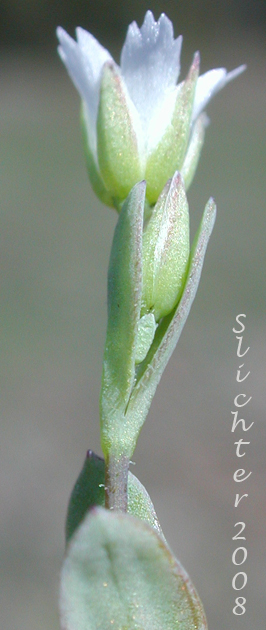
 The
photo at right shows a closeup of the sepals of jagged chickweed as seen atop the Columbia Hills..........May 1, 2005.
The
photo at right shows a closeup of the sepals of jagged chickweed as seen atop the Columbia Hills..........May 1, 2005.
Jagged chickweed is an annual or winter annual weed with a cluster of basal leaves with one to several erect or ascending stems, either simple or branched at the base, arising 5-20 cm high. The leaves are mainly basal. They are lanceolate to oblong in outline, measuring 10-20 mm long with short petioles. Two to three pairs of ovlong to ovate-lanceolate leaves are found on the lower third of the stem. These are sessile with blades from 10-35 mm long. The stems and leaves are generally covered with gland-tipped hairs.
The inflorescence is a terminal umbel-like cyme of 4-16 flowers. The slender pedicels are 2-3 cm long. The 5 sepals are about 3 mm long while the 5 white petals extend slightly past the sepals. The petals have jagged or tattered edges.
A weedy species, jagged chickweed may be found in disturbed areas and waste areas, and is especially abundant in the grain fields and range areas to the east of the Cascades.
Native to Eurasia, jagged chickweed may be found across much of North America. In the Pacific Northwest it may be found from along the Snake and Columbia Rivers of eastern Washington, northeastern Oregon and western Idaho.